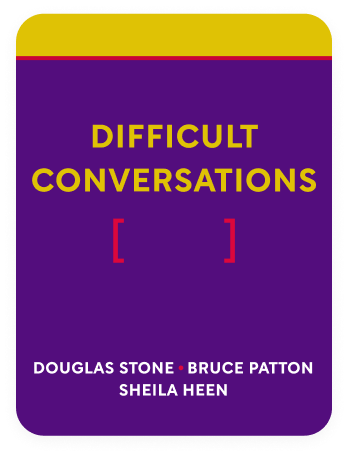

This article is an excerpt from the Shortform book guide to "Difficult Conversations" by Douglas Stone, Bruce Patton, Sheila Heen. Shortform has the world's best summaries and analyses of books you should be reading.
Like this article? Sign up for a free trial here .
How do you hold and manage difficult conversations? What can you do to keep the conversation on track and not let it escalate into an argument?
In business and in personal matters, difficult conversations come up all the time. But if we can learn how to manage difficult conversations more productively, our relationships and our lives will improve tremendously.
Here are three “power moves” that can help you manage difficult conversations in spite of the other person’s lack of cooperation.
How to Manage Difficult Conversations
Difficult conversations are so difficult first and foremost because of how we approach them. Most of us approach difficult conversations as though we are right and the other person is wrong, as though our feelings are the most important, and as though we have to either “win” the conversation, or risk “losing it.” Learning how to manage difficult conversations constructively starts with letting go of this competitive attitude.
There are three “power moves” that can help manage difficult conversations in spite of the other person’s lack of cooperation: reframing, listening, and naming the dynamic.
1) Reframing
Reframing is listening to the other person’s contributions and translating them into more helpful ones. It usually uses the Three Conversations as the translation categories.
Reframing helps keep a conversation on track when the other person is heading down a destructive path and helps you translate negative statements into useful ones. And it almost always works: anything the other person says, you can usually reframe it as a helpful contribution to a learning conversation.
You can reframe:
- Facts or truths as differing stories.
- Accusations as impact and intention.
- Blame as contribution.
- Judgments as feelings.
- Comments about what’s wrong with you as insight into what’s happening to them.
Some examples of how to reframe:
- “It’s all your fault” can be reframed as “I know I’ve contributed to the issue — we both have. Instead of focusing on whose fault it is, can we explore how we both got here?”
- “I’m not a bad neighbor” can be reframed as “I don’t think you are either, and I hope you don’t think I’m a bad neighbor. I think we disagree about how this issue should be handled, and I think even good neighbors sometimes disagree on how to handle things. I’m hoping we can work together to make sure both our concerns are addressed.”
Though a single sentence can’t turn a whole conversation around, hopefully, these examples give you an idea of how to reframe constructively.
2) Active Listening
Active listening can go a long way in helping you manage difficult conversations. When you listen, you get information that is crucial to directing the conversation. If they get emotional, listen and acknowledge their feelings. If they refuse to accept your version of the story, paraphrase what you’re getting from their story and ask them questions about their perspective. If they accuse you of something, try to understand where they’re coming from before you defend yourself.

———End of Preview———
Like what you just read? Read the rest of the world's best book summary and analysis of Douglas Stone, Bruce Patton, Sheila Heen's "Difficult Conversations" at Shortform .
Here's what you'll find in our full Difficult Conversations summary :
- Why healthy relationships need difficult conversations
- The 3 conversations that happen within each difficult conversation
- How difficult conversations go wrong and what to do about it






